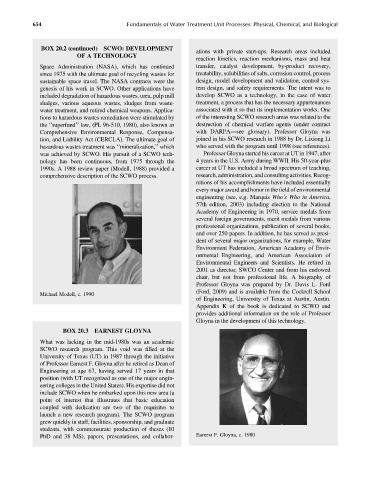Page 699 - Fundamentals of Water Treatment Unit Processes : Physical, Chemical, and Biological
P. 699
654 Fundamentals of Water Treatment Unit Processes: Physical, Chemical, and Biological
BOX 20.2 (continued) SCWO: DEVELOPMENT
ations with private start-ups. Research areas included
OF A TECHNOLOGY
reaction kinetics, reaction mechanisms, mass and heat
Space Administration (NASA), which has continued transfer, catalyst development, by-product recovery,
since 1975 with the ultimate goal of recycling wastes for treatability, solubilities of salts, corrosion control, process
sustainable space travel. The NASA contracts were the design, model development and validation, control sys-
genesis of his work in SCWO. Other applications have tem design, and safety requirements. The intent was to
included degradation of hazardous wastes, urea, pulp mill develop SCWO as a technology, in the case of water
sludges, various aqueous wastes, sludges from waste- treatment, a process that has the necessary appurtenances
water treatment, and retired chemical weapons. Applica- associated with it so that its implementation works. One
tions to hazardous wastes remediation were stimulated by of the interesting SCWO research areas was related to the
the ‘‘superfund’’ law, (PL 96-510, 1980), also known as destruction of chemical warfare agents (under contract
Comprehensive Environmental Response, Compensa- with DARPA—see glossary). Professor Gloyna was
tion, and Liability Act (CERCLA). The ultimate goal of joined in his SCWO research in 1988 by Dr. Lixiong Li
hazardous wastes treatment was ‘‘mineralization,’’ which who served with the program until 1998 (see references).
was achieved by SCWO. His pursuit of a SCWO tech- Professor Gloyna started his career at UT in 1947, after
nology has been continuous, from 1975 through the 4 years in the U.S. Army during WWII. His 50-year-plus
1990s. A 1988 review paper (Modell, 1988) provided a career at UT has included a broad spectrum of teaching,
comprehensive description of the SCWO process. research, administration, and consulting activities. Recog-
nitions of his accomplishments have included essentially
every major award and honor in the field of environmental
engineering (see, e.g. Marquis Who’s Who in America,
57th edition, 2003) including election to the National
Academy of Engineering in 1970, service medals from
several foreign governments, merit medals from various
professional organizations, publication of several books,
and over 250 papers. In addition, he has served as presi-
dent of several major organizations, for example, Water
Environment Federation, American Academy of Envir-
onmental Engineering, and American Association of
Environmental Engineers and Scientists. He retired in
2001 as director, SWCO Center and from his endowed
chair, but not from professional life. A biography of
Professor Gloyna was prepared by Dr. Davis L. Ford
(Ford, 2009) and is available from the Cockrell School
Michael Modell, c. 1990
of Engineering, University of Texas at Austin, Austin.
Appendix K of the book is dedicated to SCWO and
provides additional information on the role of Professor
Gloyna in the development of this technology.
BOX 20.3 EARNEST GLOYNA
What was lacking in the mid-1980s was an academic
SCWO research program. This void was filled at the
University of Texas (UT) in 1987 through the initiative
of Professor Earnest F. Gloyna after he retired as Dean of
Engineering at age 67, having served 17 years in that
position (with UT recognized as one of the major engin-
eering colleges in the United States). His expertise did not
include SCWO when he embarked upon this new area (a
point of interest that illustrates that basic education
coupled with dedication are two of the requisites to
launch a new research program). The SCWO program
grew quickly in staff, facilities, sponsorship, and graduate
students, with commensurate production of theses (10
PhD and 38 MS), papers, presentations, and collabor- Earnest F. Gloyna, c. 1980

